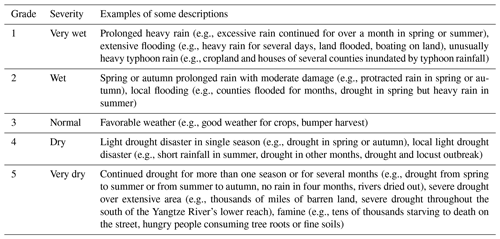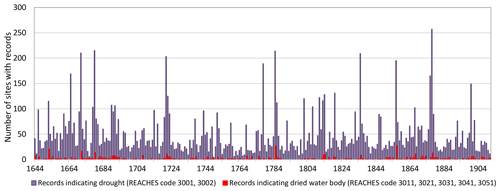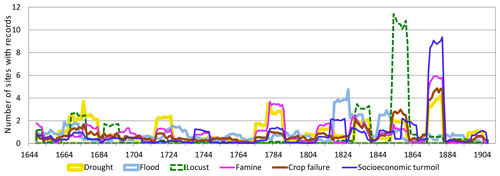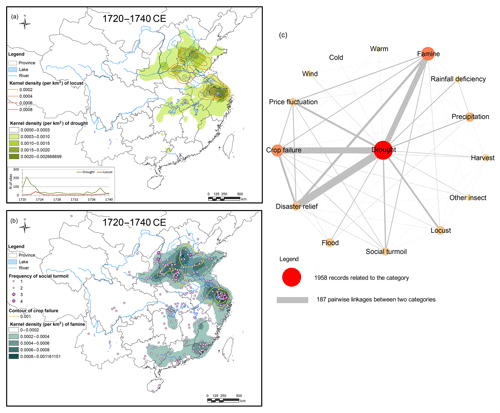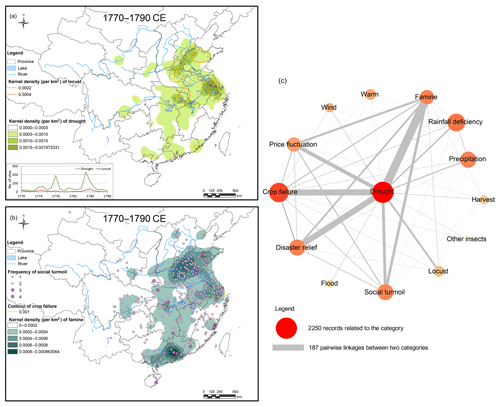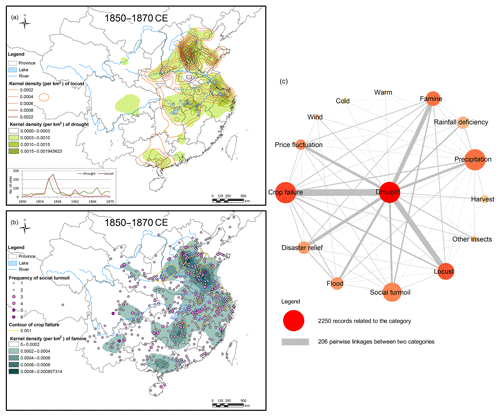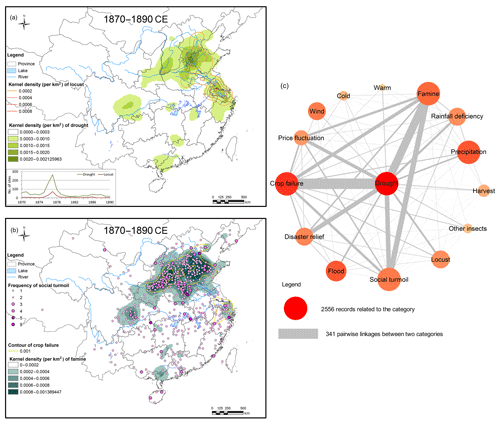the Creative Commons Attribution 4.0 License.
the Creative Commons Attribution 4.0 License.
Historical droughts in the Qing dynasty (1644–1911) of China
Kuan-Hui Elaine Lin
Pi-Ling Pai
Yu-Shiuan Lin
Chih-Wei Wang
This study presents a new epistemological analysis of drought chronology through a well-defined methodology for reconstructing past drought series, as well as series of other associated ecological and societal impact variables. Instead of building a grading system based on mixed criteria, this method facilitates transparency in the reconstruction process and enables the statistical examination of all variables when building series. The data for the present study are derived mainly from the REACHES (Reconstructed East Asian Climate Historical Encoded Series) database; however, other archival documentary and index data from independent sources are also applied to understand drought narratives and to cross-check and validate the analysis derived from REACHES. From the time series analysis, six severe drought periods are identified in the Qing dynasty, and then a spatial analysis is performed to demonstrate the spatial distribution of drought and other variables in the six periods, as well as a social network analysis to reveal connections between drought and other ecological and societal variables. Research results clearly illustrate the role of human intervention in influencing the impacts of drought and their societal consequences. Particularly, the correlation between drought and socioeconomic turmoil is not strong; crop failure and famine are important intermediate factors, while ecological factors such as locust and disaster relief measures are all imperative to intervene between crop production and famine. Implications of the study on drought impact are provided, as well as the significance of drought on historical climate reconstruction studies.
- Article
(12587 KB) - Full-text XML
- BibTeX
- EndNote
Global warming is expected to influence the earth's hydrological cycle and put greater stress on water resources. Climate simulations reveal a wide expansion of dry areas over land and an intensification of wet–dry contrast at lower latitudes (Held and Soden, 2006; Schewe et al., 2014). There are some recent observations that hint at the agreement with the projected enlarging wet–dry contrast pattern and intensified drought (Schewe et al., 2014), although substantial uncertainties about specific patterns and trends remain. Even less understood is the interannual- and decadal-scale change patterns of regional precipitation and the duration and magnitude of drought at finer spatial and temporal resolutions (IPCC, 2013). Obviously, more high-quality hydroclimate data are necessary if we wish to remove these uncertainties. Such data are also necessary for assessing the performance of climate models, especially on their capability in projecting reliably the climates of the next few decades. The length of the instrumental meteorological data series is only a little more than a hundred years, which is not long enough to assess the validity of climate models that make predictions for many decades into the future (Cook et al., 2014; Ljungqvist et al., 2016).
The most direct manifestation of hydroclimate variability is drought and the flooding of the environment (Routson et al., 2016; Stevenson et al., 2018). Drought and flood are two extremes of the hydrological cycle, and both can induce severe environmental and socioeconomic consequences. A flood, which generally represents the sudden onset of excessive water, can lead to immediate loss of lives and material damages. The formation of drought, on the contrary, normally refers to a slower and longer water deficiency process that can result in a more chronologically extended range of impacts on agriculture and water scarcity, contributing to catastrophic socioeconomic outcomes (Brázdil et al., 2019). Given the intensified drought conditions in the future scenarios as described above, there is an urgent need to study past droughts, especially the severe drought cases, to decipher their occurrence, duration, magnitude, and the associated ecological and societal consequences for implications of future adaptation.
Studying past drought and humidity has been a long practiced subject in historical climatology and paleoclimatology (Stahle et al., 2007; Tan and Liao, 2012; Yi et al., 2012; Cook et al., 2015; Ge et al., 2016; Hao et al., 2016; Brázdil et al., 2018; Shi et al., 2018). In the instrumental era, drought is relatively easy to define based on temperature and precipitation measurements. The instrumental era can be traced back to the mid or late 19th century, when many national weather services started (Broennimann et al., 2018). Some early instrumental meteorological data might be acquired in some regions, dating back to the late 17th and early 18th centuries. Prior to the instrumental era, there were primarily two sources of data that can be used to build drought series of high temporal resolution: tree-ring data and documentary records (White, 2019). Tree rings provide abundant information about moisture, and sometimes temperature, for reconstructing millennial-long hydroclimate indices from which drought can be inferred. The most well-known works include the Old World Drought Atlas (Cook et al., 2015), which uses tree-ring data and is calibrated with the Palmer Drought Severity Index (PDSI) (Palmer, 1965), the Monsoon Asia Drought Atlas (Cook et al., 2010), and “Tree-ring reconstructed megadroughts over North America since A.D. 1300” (Stahle et al., 2007). Yet, tree-ring reconstruction often suffers from the uncertainty in the seasonal growth of trees and the ambiguous interpretation of isotopes (Schofield et al., 2016). Nonetheless, high-quality quantitative drought index series, such as the Standardized Precipitation Index (SPI) (Mckee et al., 1993), the Standardized Precipitation Evapotranspiration Index (SPEI) (Vicente-Serrano et al., 2010), the PDSI, and the Palmer Z-Index, can also be reconstructed from documentary data. For example, Brázdil et al. (2016) and Možný et al. (2016) have built monthly, seasonal, half-year, and annual resolution SPI, SPEI, Z-Index, and self-calibrated PDSI series for the Czech lands. Moreover, some other special drought index series were developed in Europe like the Drought Rogation Index in Spain (Barriendos, 1997) and the Drought Index in Italy (Diodato and Belocchi, 2011).
Documentary records reflect direct human observations of weather conditions and are less ambiguous when used for reconstructing past climates. They contain weather, climate, and phonological and socioeconomic situations in specific locations in various time resolutions such as daily, monthly, or seasonal, allowing the comprehensive analysis of drought events, scales, and contexts (Brázdil et al., 2019; Huang et al., 2019). To be sure, there are also some criticisms about inferring drought from documented records; for example, it is sometimes hard to distinguish whether the drought record refers to a rainfall deficiency, hydrological process, or crop irrigation need. Several studies tried to remedy this by proposing four categories of drought: meteorological drought caused by significant reduction of precipitation for weeks or months compared to normal precipitation; agricultural drought associated with lack of water for plant growth for a period lasting from weeks to 6–9 months; hydrological drought characterized by a shortage or absence of water in water courses, reservoirs, or aquifers; and socioeconomic drought caused by the negative effect of drought on everyday life, social systems, and stability (Heim, 2002; Brázdil et al., 2018). There is yet another view suggesting that drought is a complicated process of water shortage caused and modified by human processes (Van Loon et al., 2016). Despite such shortages, documentary records are still one of the most important sources for reconstructing drought series, only we have to be very careful in extracting proper information from them.
Brázdil et al. (2018) have described various types of documentary records that can be used for extracting drought information. Before the instrumental era, all historical climate records were essentially qualitative or narrative in nature, and it is necessary to transform them into numerical data series so that statistical analysis of them can be performed. The most common practice is to design a three-, five- or seven-grade system based on the duration and severity of drought (Zheng et al., 2014; Brázdil et al., 2018) so that every single quotation of drought recorded can be assigned a specific value according to the grading criteria. By arranging these grades as a sequence in time, we get a time series of drought grade, often called a drought index series. In reality, however, the transformation process from qualitative narratives to digital series can be tricky because a wide spectrum of grade assignment strategy exists and different investigators can derive very different index series based on the same set of drought records. More detailed discussions on this matter have been given by Brázdil et al. (2005) and Pfister et al. (1999).
In China, a dryness–wetness (also referred to as drought–flood) index has been widely used in recent decades for reconstructing past climates (Tan and Liao, 2012; Yi et al., 2012; Zheng et al., 2014, Hao et al., 2016; Shi et al., 2018; for detailed review on historical climate records in China and a reconstruction of past climates, please refer to Zhang and Crowley, 1989). The index series was initially built by the Academy of Chinese Meteorological Science (CMA, 1981; Wang and Zhao, 1981), based on historical documentary records, and was sequentially expanded by several Chinese scholars (see Zhang, 2003; also see Hao et al., 2020). The index system, based on Yi et al. (2012) with modifications from Zheng et al. (2014) and Tan et al. (2012), specifies a five-grade scheme as described in Table 1.
This scheme uses mixed meteorological, hydrological, and socioeconomic criteria to determine the drought grade to form China's dryness–wetness index series. This system has the advantage of evaluating drought severity; however, it is difficult to identify specific drought categories in the records, as mentioned earlier. Thus, one cannot identify whether or not a certain drought event was associated with a meteorological deficiency of rainfall or had more to do with the failure of the agricultural irrigation systems. This can lead to a biased interpretation of drought records as representing the atmospheric humidity condition. It also prevents proper statistical associations among different drought categories (each as an independent variable) and could lead to erroneous conclusions about the nature of the drought and its impact.
This study takes a new conceptual point in examining the drought records and proposes a new method to reconstruct past drought series and other associated ecological and societal variables from Chinese historical documentary records. Our objective is to make the interpretation of every drought and associated variables as clear and operationally independent as possible. This method can facilitate the statistical examination of these variables and enable transparency in the reconstruction process of historical drought series. Moreover, we will also perform a contextual analysis of severe drought events by analyzing the strength of relation among different variables and at the same time by examining their spatial characteristics. In order to assess more clearly the true nature of the drought event, we acquired more archival information from historical documents so as to gauge governmental and societal responses to severe drought events.
In the following sections, we will first briefly introduce the data used for analysis (Sect. 2). Then the methods will be described (Sect. 3), followed by the presentation of the results of the time series analysis of those variables. We will then examine the six severe drought periods, their spatiotemporal patterns, and the details of the narratives (Sect. 4). Finally, the climate–society interaction will be explored, followed by an outlook on future research work (Sect. 5).
2.1 Drought and associated data from the REACHES database
The main data source of this study is the REACHES (Reconstructed East Asian Climate Historical Encoded Series) database, which is a digitized and category-coded climate record of Chinese historical documents from the last three millennia (readers are referred to Wang et al., 2018, for detailed descriptions of the database). The present study utilizes only the records from the last imperial dynasty of China, i.e., the Qing dynasty (1644–1911). There is a total of 93 415 records (database version VOL34-V3.1-04-E2) from this period, and we retrieved drought and related records including on locust outbreaks, dried water bodies (representing hydrological drought), crop failures (representing agricultural drought), famines, and socioeconomic turmoil (along with famine to represent socioeconomic drought). Locust outbreak is an important ecological indicator closely related to drought and famine as locust outbreaks often occur in drought conditions, and these insects consume great quantities of crops, resulting in widespread famine and even cannibalism (Huang et al., 2019). Rigorous statistical studies on locust outbreaks and their relation to drought and the societal impacts they cause are rarely performed.
REACHES has a sophisticated code system to include as much information as conveyed in the historical records. It uses a nine-digit code scheme: the first two digits describe the main category of the climate nature (for example, precipitation, temperature). The next two digits describe the subcategory (for example, rainfall and snow are two of many subcategories under the precipitation category), and the next three digits describe special vocabularies (for example, light rain and torrential downpour under the rainfall subcategory). The last two digits denote the magnitude and time information. As an example, a code of a record 300130156 can be deciphered as follows: the first two digits “30” indicate that the record belongs to the main category of drought, and the next two digits “01” indicate that it is in the “drought” subcategory (i.e., the record says “drought” directly). There are other subcategories related to drought, but they were described in different contexts; for example, “watercourse dried out” is assigned as subcategory 11. The next three digits “301” indicate that its vocabulary is major drought (Kang Han). The last two digits “56” denote magnitude and time-duration information. In this case, “5” means the magnitude is “heavy and occurred many times”, and “6” indicates the event duration lasted between 60 and 90 d.
Famine is also a main category item with the code 35. On the other hand, locust outbreak is a subcategory (code 01) item under the main category of pest/vermin (code 32). Thus, the complete code representing a locust record is 3201. Crop is a main category item (code 33) that comprises various degrees of harvest conditions and crop species, and a vocabulary code system ranging from 100 to 499 is assigned to describe them individually. Similarly, socioeconomic turmoil is a main category item with code 71, and the subcategory items most relevant to this study include immigration/displacement (code 03, so the full retrieval code is 7103), battle/war (code 05), impoverishment (code 09), death/severely injured (code 10), human trafficking (code 12), and abandoned settlements (code 16).
As the historical documents were written by a great variety of author types, not all of them were written in a fixed standard style, and special care must be taken to denote and encode these records. For example, some records sometimes use a negation to describe the absence of a phenomenon which should take place around the time, such as “no drought” (Wu Hang). In this case, it would be encoded under the drought category with magnitude code 8 denoting “not occurring”. Since “no drought” items should not be taken into the drought series in this study, we have carefully removed all those records with magnitude code 8 in the data series.
Finally, and importantly, all records of REACHES are taken from the Compendium of Chinese Meteorological Records of the Last 3000 Years (Zhang, 2013), which includes only records that have direct (or indirect) implications or linkages with meteorological phenomena. Those not directly related to meteorological matters were not included in the Compendium. In particular, some socioeconomic events that are not explicitly linked to climate conditions may not be included in the Compendium but, as often happens in human society, they may be linked in some indirect way. This means that care must be taken when using and analyzing the socioeconomic variables in REACHES because of the potentially biased sampling. Other sources of relevant socioeconomic data should be considered to cross-check and validate the analysis.
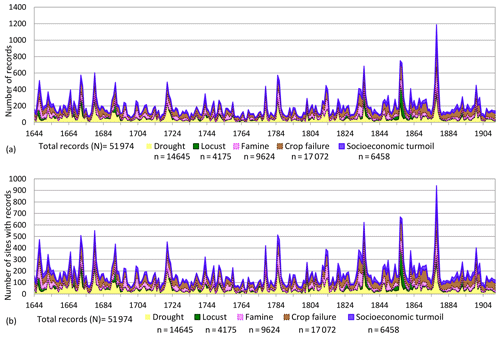
Figure 1Time series plots of drought and associated series derived from the REACHES database. Panel (a) shows the number of records per year and panel (b) shows the number of sites (counties, cities, or prefectures) that have records for the year. Thus, one site may have more than one record for the year. Note that the drought variable here includes meteorological and dried-water-body-related hydrological drought, crop failure is interpreted as agricultural drought, and famine and socioeconomic turmoil are taken to represent socioeconomic drought.
We retrieved 51 974 records related to drought and other related variables from the REACHES database (version VOL34-V3.1-04-E2) for the period 1644–1911. Figure 1a shows the time evolution of records for the variables of drought, locust, crop failure, famine, and socioeconomic turmoil, and Fig. 1b shows the number of sites (i.e., counties, cities, and prefectures in REACHES. Total number of sites with drought records =1404) that have the corresponding records of the year. The two diagrams exhibit almost identical trends, showing good general consistency of the data series of these variables, and it is also highly likely that the records are evenly or randomly distributed over the sites. All data derived from the REACHES database pertinent to this study will be deposited at NOAA's National Centers for Environmental Information (https://www.ncdc.noaa.gov/paleo/study/29472, last access: 21 May 2020).
2.2 Other archival and index data
As mentioned previously, the Compendium does not focus on and hence collect in a comprehensive manner socioeconomic events; therefore, sampling bias may exist. To comprehensively compare and analyze drought and associated data series from REACHES with socioeconomic variables, we have consulted independent documentary sources aside from the Compendium. These include the Draft History of Qing (Qingshi Gao), the Veritable Records of Emperors of the Qing Dynasty (Qing Shilu), gazetteers from Xunzhou Prefecture (Tongzhi reign edition) ((Tong Zhi) Xun Zhou Fu Zhi), gazetteers from Gui County (Guangxu reign edition) ((Guang Xu) Gui Xian Zhi), gazetteers from Pingnan County (Guangxu reign edition) ((Guang Xu) Ping Nan Xian Zhi), and gazetteers from Yongchun County (Chinese Republican Period edition (Min Guo)) (Yong Chun Xian Zhi). Practically, it might be unavoidable that some of the contents in the historical books, if referring to climatic and weather conditions, are quoted in the Compendium. For example, there are five quotations of records from the Veritable Records of Emperors of the Qing Dynasty and 148 records from the Draft History of Qing found in REACHES among the overall 93 415 records from the Qing dynasty. The coverage, however, is minimal in quantity among them all, while these documents contain meticulous records of social, economic, and institutional events of the time. Local gazetteers particularly contain detailed information about social unrest such as the massive rebellion, the Taiping Civil War (Tai Ping Tian Guo), in the mid 19th century.
Besides the above documents, we also collected records on grain price, civil war, and population indices for further analysis. Grain price data (1738–1911) were derived from the Qing Dynasty Grain Price Database, which compiles the monthly grain price reports preserved in the First Historical Archives of China in Beijing and the National Palace Museum in Taipei by Wang (2009). Civil war data that reveal the frequency of civil wars in the Qing Dynasty were derived from the Chronology of China's Ancient Wars by the Chinese Military History Writing Group (1985). Population index data come from several different sources: provincial population statistics 1661–1776 CE from the Encyclopedia of Official Documents of the Qing Dynasty (Qingchao Wenxian Tongkao); provincial population statistics 1780–1890 from the Annual Registers of Quantities of Provincial Population and Grain Storage by the Ministry of Revenue (Gesheng Minshu Gushu Qingce); and the History of Population in China, Vol. 5: Qing Dynasty (Zhongguo Renkoushi Diwujuan Qingshiqi) by Cao (2001).
3.1 Time series and cross-checking of the variables
We used the retrieved records to build several time series for different variables and performed tests to cross-check the reliability and robustness of the drought data. First of all, we gave strict definitions for the drought variable. In this analysis, the drought variable only corresponds to those records with the vocabulary category of drought (such as Tien Han, Kang Han, and Ku Han, all with category code 3001), enduring scorching sun, sultry weather (e.g., Heng Yang, with code 3002), and different types of dried out water bodies, which include dried watercourses (e.g., Shuei Jyue, code 3011), dried tide/sea water (e.g., Chao Shuei He, code 3021), dried lake/pond (e.g., Hu He, code 3031), dried underground water (e.g., Wu Quan, code 3041), and dried river/creek (e.g., He Shuei Jyue, code 3051). We further divided the drought records into two groups: one group that consists of pure drought vocabularies (codes 3001 and 3002) is interpreted as meteorological drought and the other that consists of dried water bodies (codes 3011–3051) is interpreted as hydrological drought. Figure 2 shows the comparison of the time series. We found that a higher number of hydrological drought records often occurred in the years having more meteorological drought records. The correlation coefficient of the two is 0.67, and the coefficient increases to 0.77 when only severe drought (to be explained later) is considered. This finding indicates that the large majority of hydrological drought in China can be caused by metrological drought; however, the relation is not perfect.
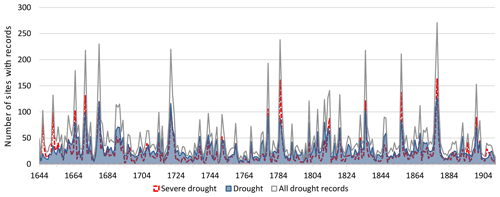
Figure 3Time series plot of annual normal drought, severe drought, and all drought populations in REACHES during the Qing dynasty.
To further understand the impact of different drought types, we divide drought events into normal drought and severe drought. The criteria of severity assignment are based on the attributes of the vocabulary used and the duration described in the record. Records that contain adjectives indicating extreme or severe drought (magnitude code 2 and 5) or indicate that the event lasted for more than 2 months (time-duration code 6 and 7) are categorized as severe drought. In contrast, those records that do not have any adjectives indicating the severity or those with a duration of less than 2 months are categorized as normal drought. In this way we form the annual drought population and annual severe drought population series, and Fig. 3 shows the time series plot of these two series. It is obvious that the severe drought and normal drought series have good consistency and match very well especially for the peak years of the drought events. Remarkably, those peak drought years mostly appeared in the mid to late 17th century and after the late 18th century. The top 3 % of the drought years (those with more than 169 records for the year) are the years 1665, 1671, 1679, 1721, 1778, 1785, 1835, 1856, and 1876.
3.2 Spatial analysis of kernel density estimation
Precise geographical information in REACHES makes it relatively easy to perform a spatiotemporal analysis of the climate data series derived from it. There are in total 1660 sites representing cities, counties, or prefectures in the REACHES database. We performed the spatial analysis of the kernel density function for the drought data. We first determined the number of certain kinds of records each year, and the numbers were summed over the time period defined for the analysis. For example, in the 1720–1740 severe drought, Baoshan district of Shanghai City had three drought records occurring separately in the years 1720, 1723, and 1724. The frequency for the period of Baoshan district would therefore be three. We then used ArcGIS (version 10.4) to relate the data to the maps and implemented the kernel density function to conduct spatial analysis.
Kernel density estimation is a non-parametric method to estimate the probability density function of a random variable. In ArcGIS it is often used to calculate the density of point features around each raster cell depending on the geographic distance and value of certain features. Namely, every cell value is the highest at the location of the point features, diminishes with increasing distance from the point, and reaches zero at the search radius distance, called bandwidth, from the point. On every data point, a kernel function K can be expressed as Eq. (1):
where is the estimated density value at location (xy), n is the value of the point of concern (for example, in this case, n is the number of drought records during the period), h is a measure of bandwidth (for a circular kernel it is the radius of the circle), and di(x,y) is the distance between the point i and location (xy). Equation (1) shows that K is a density function characterizing how the contribution of point i varies as a function of di(x,y).
Thus, the method estimates a smoothly curved kernel surface fitted over each point depending on the point value and the values of its neighboring points within the desired bandwidth. The choice of bandwidth is therefore important since a larger bandwidth would result in a more smoothened surface when considering the point value of a larger distance. In the environment of ArcGIS, the kernel density estimation is based on the quadratic kernel function (Silverman, 1986).
3.3 Social network analysis
To explore statistical characteristics of the relations between one variable and other variables in the drought data set, we performed a social network analysis. This analysis allows us to understand more quantitatively the underlying relations of all variables. Social network analysis is a statistical method widely applied in sociology to explore how different agents are connected with each other so as to decide their distinctive network types and to analyze if and how various types of networks would influence individual behaviors and performances (Lin, 1999; Scott, 2017). In this study, we treated each variable as an independent agent and then calculated their statistical relations.
Generally, social network analysis adopts a pairwise approach to calculate relations between variables (e.g., if agent A is linked with agent B). Thus, to implement the analysis, data transformation is needed to display and inventory events (with specific codes) under every single record. For example, one record says that “in 1833, Guangling County of Shanxi Province, the misery [of the year] began with drought, followed by excessive rainfall, and ended with frost damages. The rice costed a thousand per dou [traditional Chinese volume unit, equivalent to 10 Chinese liters]. There hadn't been so extreme in the previous several decades” (1833) (record ID 2945-25). To perform the social network analysis, we deconstructed the record so that the drought, excessive rainfall, and frost damages are each listed as separate events, and then we calculated the pairwise coefficients between different variable pairs, e.g., drought with rainfall, drought with frost, or drought with rice price. When all events of every record had been deconstructed and restructured following the algorithm, then the analysis could be performed to estimate the magnitude of every event (i.e., variable) and to calculate the strength of connections among those variables during certain time periods. The function of edge list was applied to perform this analysis with Gephi software (https://gephi.org/, last access: 15 March 2020).

Figure 4Time series plots of socioeconomic turmoil, famine, crop failure, locust, drought, and the Chinese monsoonal annual temperature anomaly reconstructed from REACHES. The bottom panel shows assembled Northern Hemisphere temperature anomalies from Frank et al. (2010). Periods with more frequent drought records are highlighted in yellow bars.
4.1 Chronologies of drought and related variables
Figure 4 shows the time series of all variables (in their annual values) reconstructed from the REACHES database. There are two temperature time series in the lowest part of the figure for comparison purposes to be discussed later. Naturally there are multidecadal and centennial variabilities which are more obvious in some periods amid regular fluctuations in 1644–1911.
One of the unique features of Fig. 4 is the inclusion of the locust outbreak series. While there had been studies on locust outbreak and climate, Wang (1985) was perhaps the first one to utilize Chinese historical records of locust outbreaks to investigate their temporal and spatial behaviors. The analysis we present here will further reveal how close this biological phenomenon is related to the climate factor.
We first observe that there appears to be a good synchronization of large amplitude events (high peaks in the curves) for all variables in six periods highlighted by light yellow columns. These periods are roughly as follows: 1665–1680, ∼1720, 1770–1790, the 1830s, the 1850s, and the 1870s, and the periods are also correspondent to the top 3 % of drought years in the previous analysis (Sect. 3.1). The most prominent of the synchronization is between the locust and drought series, which is to say that locust outbreaks occurred most often during high drought occurrence periods. The close relation between locust outbreak and drought has been known in China since ancient times. For example, the famous poet of the northern Song dynasty (960–1127 CE) Su Shi (1037–1101) wrote in his poem “Rhymed after Zhang Chuandao's `Happy for the Rain', made after I prayed for rain in Changshan Temple”: “As always locust and drought will occur together, this is what I learned from old farmers”. Chen Fangsheng, a Qing dynasty scholar, authored the book A Study on Catching Locusts (Bu Huang Kao), published in 1776, in which he commented “when drought becomes extreme, locust outbreak occurs”. The synchronization in the two series thus provides a statistical verification of this ancient wisdom.
The synchronization is not limited to drought and locust. Other variables exhibit similar behaviors. Thus, Fig. 4 shows that when drought occurs, it is very likely that a locust outbreak will occur, as well as crop failure, famine, and socioeconomic turmoil. We have not yet gone into the detailed ramifications of the cause and effect analysis of this synchronization, but the order of events as described in the previous sentence seems to match the “common sense” that under the general background of drought conditions, a locust outbreak has a high chance to occur, which in turn results in crop failure causing famine. Finally, in the absence of effective intervention by the government, socioeconomic disasters occur. We are currently collecting more evidence to further study such links.
In order to further understand this synchronization feature, we calculated the 9-year running variance for the time series as shown in Fig. 5. The six periods identified previously now become even clearer. Notwithstanding the synchronization of high occurrence, however, the amplitudes of the variables are not related linearly. While the amplitudes of drought are more or less even in the six periods, the amplitudes of other variables seem to vary significantly. For example, locust outbreaks were more numerous in 1660–1680, the 1830s, and the 1850s (the highest peak). There were fewer in the rest of the three periods. On the other hand, there were fewer famines in the 1600s, but they became more numerous in 1770–1790 and the 1850s and peaked in the 1870s. Socioeconomic turmoil had a relatively low amplitude in the early and mid-Qing dynasty until the 1820s when it showed an increase and peaked in the 1870s. This is just to say that the correlations of these series are not perfect, and their relations are nonlinear; however, they have a tendency to occur in the same period. Table 2 shows correlation coefficients among all those variables. We see that drought is highly correlated with crop failure and famine but is less correlated with locusts and socioeconomic turmoil. This probably can be interpreted as drought resulting directly in crop failure which very likely led to famine, but there were circumstances in which a locust outbreak did not occur during the drought. The real reason needs to be investigated further. It is possible that measures of locust prevention had sometimes been taken effectively and not so in other times. Likewise, the socioeconomic situation would not be that directly linked to drought if the government provided adequate relief (provide food, tax waiver, etc.). We plan to look into more details about the relations among these variables in the future.
To further understand the multidecadal and centennial variabilities, we compare these series with two temperature series: one reconstructed from REACHES (Lin et al., 2019) and the other from the assembled Northern Hemisphere temperatures of Frank et al. (2010). The two temperature series show similar trends in anomalies which appear to augment the reliability of data derived from REACHES. Figure 4 shows that the higher frequency of all the drought-related variables tends to occur more often when temperatures were lower in the 17th century and after the late 18th century. Thus, colder periods in historical times also tend to be periods of low agricultural yields and social instability, which is consistent with some previous studies (Pei et al., 2019; Su et al., 2016; Wei et al., 2017)
All coefficients have a p-value < 0.001 in Table 2. Note that we have in Sect. 3.1 identified the correlation coefficient between meteorological drought and hydrological drought as 0.67, which increases to 0.77 when severe drought is considered.
4.2 The spatial pattern of drought during the six high-occurrence periods
In the above analysis, we identified six periods in which the drought-related variables exhibit nearly synchronous fluctuations. We now would like to demarcate more precisely these periods based primarily on the drought series. In doing so, we also considered auxiliary information we found in the aforementioned historical documents such as the Draft History of Qing, the Veritable Records of Emperors of the Qing Dynasty, and the gazetteers. For example, during the period 1720–1740, the severe drought mainly occurred around 1720, but the drought soon continued in the 1730s and 1740s, and their socioeconomic effects were closely linked. So it seems to be strategically prudent to consider the period 1720–1740 as a high severity period. On the other hand, the three severe drought periods in the 1800s appear to be less closely linked in time (one peak every two decades), and the auxiliary information shows that their socioeconomic consequences were not closely linked either. Thus, we do not see the necessity of lumping the three periods together. In this way, we demarcate the six severe drought periods in the Qing dynasty as follows: 1665–1691, 1720–1740, 1770–1790, 1830–1850, 1850–1870, and 1870–1890.
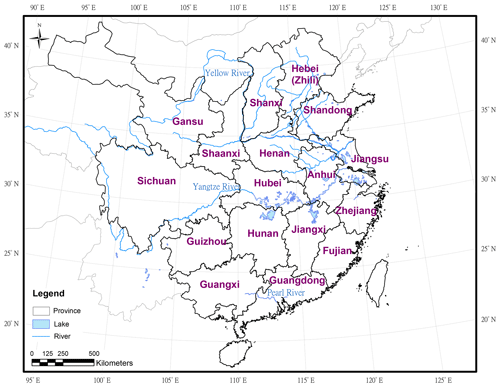
Figure 6Provincial boundaries and names in the eastern part of China. The basic latitude and longitude grid map is from the Esri data set, and provincial and city and county boundary and river shapefiles are from the Chinese State Bureau of Surveying and Mapping, Digital Map Database of China (1990 version).
In the following, we will examine the spatial distributions of the droughts and the corresponding distribution of locust outbreaks and socioeconomic turmoil. We will also provide a summary of the population and of the frequency of war and the results of the social network analysis in these six periods.
The following discussion will frequently mention provincial names in China; hence, it may be confusing for readers not familiar with Chinese geography. Figure 6 is a simplified map showing the locations of the provinces mentioned in the discussion for reference.
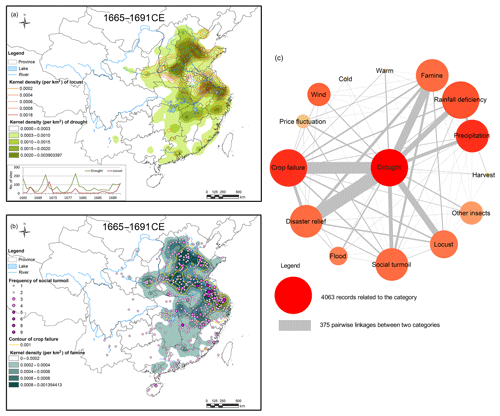
Figure 7Spatial distribution of the kernel density function of drought and locust outbreaks (a) and social turmoil (b), and the social network chart (c) in the drought period 1665–1691.
4.2.1 The period 1665–1691
Figure 7 shows the overall situation of drought-related variables in the period 1665–1691, including the spatial distribution of the kernel density function of drought (Fig. 7a), the associated locust outbreaks and social turmoil (Fig. 7b), and the social network chart (Fig. 7c). Figure 7a shows the drought kernel density distribution, which is an indicator of the severity of the drought. It is seen that in this period drought was fairly widespread in the eastern half of China from as far north as Hebei Province and as far south as Guangdong Province. There appear to be two “epicenters” of drought, one in the lower Yellow River floodplain (Hebei and Shandong) and the other in the middle and lower reaches of the Yangtze River (Anhui and northern Jiangsu). There are also secondary centers in Hubei, Jiangxi, and Zhejiang. The droughts in the south, such as in Fujian and Guangdong, were relatively mild.
Here we would like to stress an important caution when reading the spatial patterns: they should be viewed as a map of anomaly instead of a map of humidity. This is because the drought index (as well as other severity indices such as temperature) derived here represents the deviation from the local norm, and the local norm can be quite different in different locations in a country as large as China. Thus, a certain dry condition lasting for, say, a month may well be considered a drought in the normally humid southern China, but it could be regarded as a normal condition in the Loess Plateau region in northern China because their norms are quite different. There is a need of an algorithm that converts the anomaly index to actual humidity which must consider this local norm factor. An investigation is being conducted on this subject.
Figure 7a shows the pattern of locust outbreaks, and Figure 7b shows the corresponding spatial patterns of famine and social turmoil in this period. We observe that the patterns are similar to those of drought, and both are also centered around the lower Yellow and middle and lower Yangtze rivers, which again vindicates the ancient wisdom of the close relationship between drought and locusts (and the consequential social turmoil they might cause).
The period 1665–1691 is about 2 decades after the collapse of the Ming empire in 1644, which was replaced by the Manchurian Qing empire after the bloody wars among different parties, including Ming, Qing, and the rebellious farmers led by Li Zicheng. The population of China was substantially reduced due to the wars. But even at this time, revolts in different parts of China were still going on. Severe drought and locust outbreaks occurred in 1670–1672 and appeared again in 1679 and 1689–1691. Given the very similar patterns of drought, locust outbreak, and social turmoil distributions at the time, it is possible that many of these revolts were motivated by the food shortage (thus climate related) in addition to those motivated by political considerations (e.g., the Revolt of the Three Feudatories in 1673–1681). This will require further study.
4.2.2 The period 1720–1740
The 1720–1740 drought as shown in Fig. 8a appears to be not as widespread as that in 1665–1691. While there are still two centers – one in the lower Yellow River and another in the lower Yangtze River – the latter appears to be the more severe one. The corresponding locust outbreaks and social turmoil are also centered in these two regions, although those in the lower Yellow River appears to be somewhat more extensive. There was famine reported in Fujian, Guangdong, and Guangxi provinces, but there was not much corresponding drought reported in these areas. There was also social turmoil in areas not affected by drought or locust. Were these disturbances not climate related? The reason is unclear and will require further study.
There is a term in the Chinese historical community called High Qing era or the Kang Yong Qian prosperity period, referring to the period reigned over by the emperors Kangxi, Yongzheng, and Qianlong when the Chinese economy was relatively prosperous. It is often considered the golden era of the whole Qing dynasty. The demarcations of the period differ among scholars, but a generally usable one is 1684–1799 (Guo, 2002). The period 1720–1740 of concern here falls in this golden era.
Emperor Kangxi died in 1721 and was succeeded by his son, Emperor Yongzheng, after a conspiratorial process. But Yongzheng himself died in 1735 after another process also full of rumors, and his heir was Emperor Qianlong, who died in 1799. Thus, Emperor Yongzheng was the main ruler in the period 1720–1740. During this time, the whole Chinese empire was generally stable. There were some wars with minority tribes, such as the one with the Mongolian Galdan Tseren of the Dzungar Khanate, but none were extensive.
The population of China had generally grown during this period, but the drought and locust outbreaks certainly left their marks on the affected areas. According to a 1725 population record, Shandong's population grew slowly at this time, and the population of Jiangsu declined. Later famine occurred in the north of the Huai River floodplain around 1738, which is drought related and lasted for several years (Fig. 8b).
The social network analysis (Fig. 8c) shows some interesting features. The links between the pairs of drought–locust, drought–crop failure, and drought–famine, though still significant compared to other pairs, were much weaker than in the previous period. This seems to indicate that while drought occurred, the societal impact was relatively mild. Although the real reasons still need to be researched carefully, there is documentary evidence showing that the governmental policies, such as the shipment of grain to and tax relief for the disaster-affected areas and the implementation of locust elimination, might have played a significant role here.
4.2.3 The period 1770–1790
This period was entirely under the reign of Emperor Qianlong. Five years later in 1795 he claimed to have passed the throne to his son, Emperor Jiaqing, although in reality he was still in control until he died in 1799. China was relatively stable politically in this period. It was reported that the national population had returned to that in the Ming dynasty. Only some minor revolts occurred in western China in 1771–1776 by Jinchuan tribes, who were related to Tibetan tribes, and in Taiwan in 1786–1788 led by Lin Shuangwen Tiandihui (literally Heaven and Earth Society, a secret society that still exists today). A British diplomatic mission led by George Macartney was granted an audience with Emperor Qianlong in 1793, an event that became the prelude to wars between China and western powers later.
The spatial distributions of drought and the corresponding locust outbreaks, famine, and social turmoil as shown in Fig. 9a and b are both similar to those in 1720–1740; namely, both are still centered on the lower Yellow and lower Yangtze regions and a smaller center in Guangdong in the south. Drought appears to be more mild, but affected areas appear to be wider and social turmoil appears to be somewhat worse than in 1720–1740.
The social turmoil was likely linked to social inequality due to the gap between the rich and poor. The wide spread of locust outbreaks also prompted the government to pay more attention to the technology of locust eradication, and the previously mentioned A Study on Catching Locusts was published in this period. Drought in this period led to a reduction in crop yield, resulting in famine and a sharp rise in grain price around 1779 and 1786. Figure 9c shows the social network analysis of this period.
4.2.4 The period 1830–1850
The overall political and economic situation of China was going downhill after nearly 200 years of Qing rule. The middle of Emperor Qianlong's rule was generally considered the peak of the heyday of the Qing dynasty, and by 1830 China was facing an increasing economic downturn after Emperor Daoguang assumed the throne in 1820 when his father, Jiaqing, died. Many Chinese historians consider that the overspending of Qianlong is to blame for the declining economy, especially since the discovery of the stunning corruption of his most favored minion, Heshen, who was believed to have amassed illegally a net wealth equal to 15 years worth of total tax collection by the Qing government. But from today's point of view, the challenge from western powers at the time, such as the British, French, and Germans, was probably a more serious problem. Although there were some smaller riots occurring in this period, the most well-known armed conflict was the Opium War which occurred in 1840 between the Qing and British empires. After the war, the inability of the Qing government to cope with the international pressure in various aspects was completely exposed and ushered in more serious challenges internally.
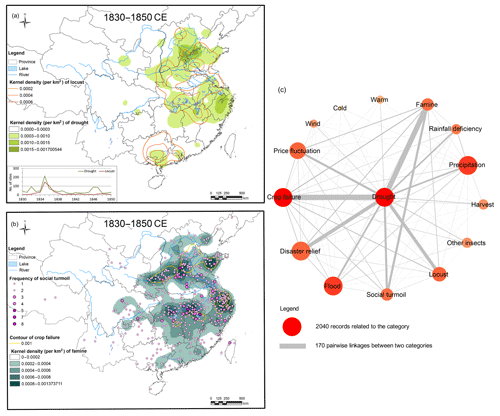
Figure 10Spatial distribution of the kernel density function of drought and locust outbreaks (a) and social turmoil (b), and the social network chart (c) in the drought period 1830–1850.
Perhaps part of the blame can be attributed to the climate factor. Figure 10a and b show the drought and the corresponding locust outbreaks, famine, and social turmoil spatial patterns. The drought conditions look similar to those in Fig. 8a, but the locust–social turmoil patterns look much worse and more widespread than in 1770–1790. Locust outbreaks and famine reached as far west as Shaanxi Province in northern China and Sichuan Province in central China, which were largely spared in the previous period, and as far south as Guangdong and Guangxi provinces. Hubei Province in central China was plagued badly by locusts and social unrest. Even the relatively wealthy province of Zhejiang had seen serious locust outbreaks and social unrest. Such relations among drought-related factors can also be seen in the social network analysis in Fig. 10c. But overall, drought is mostly related to crop failure and famine.
An interesting feature worthy of note here is the spatial patterns of locust outbreaks and social turmoil, which exhibit an east–west (E–W) orientation. There are apparently two prominent E–W belts: the north one along Shandong, southern Hebei, and southern Shaanxi provinces and the south one along Jiangsu, southern Hubei, and northern Hunan provinces.
Documentary sources show that the national population continued to grow rapidly, but per capita arable land declined significantly. Whether or not the decrease in arable land was due to climate factors remains to be studied, but there is little doubt that the society was under a great stress of resource competition. This eventually led to numerous uprisings.
One would expect that many of the uprisings must have been due to food shortages given the declining production of grains. Curiously, the rice price information in 1825–1860 which we obtained for several places including Suzhou (of Jiangsu Province), Hubei, and Guangxi paints a fairly different scene. Suzhou's rice price fluctuated more wildly but appears to have been steady when averaged throughout the period. Guangxi's rice price was very steady, and Hubei's price was even declining during this period. Perhaps this phenomenon only pertains to these few cities as we have not studied the situation of other locations. This will be left for future research.
4.2.5 The period 1850–1870
In this period, drought conditions in the Yellow River plain in Hebei and Shandong in northern China worsened, and locust outbreaks were also widespread similar to the 1830–1850 period. Figure 4 shows that the locust outbreak frequency in this period is the highest in the whole Qing dynasty. Famine occurred in locations where locust outbreaks were severe. The center of the worst condition – severe drought, heavy locust outbreaks, and high famine density – was in the combined region of Hebei and Shandong provinces, forming a northwest–southeast (NW–SE) belt as shown in Fig. 11a and b. This is in contrast to the E–W orientation of the corresponding distributions in the previous period as shown in Fig. 10. Could this difference in orientations be an indication of the regional atmospheric circulation pattern change? We will conduct further studies on this subject in the future.
This was a time when the political situation of the Qing dynasty became increasingly unstable. Emperor Daoguang died in 1850 and was succeeded by his son, Emperor Xianfeng. Rebellions erupted all over China. The deadliest one was the Taiping Rebellion led by Hong Xiuquan, who was a self-proclaimed Christian and who claimed to be the brother of Jesus Christ, which started in 1850 and ended in 1864. This is thought to be the largest-scale civil war in China in the Qing dynasty and the bloodiest. Casualties are estimated to be in the range of 10–30 million, and another 30 million fled to other settlements in China. This 14-year war impacted 18 provinces, but the region south of the Yangtze River suffered the most casualties in this conflict.
In central and northern China, it was another bloody war, the Nian Rebellion, that caused severe damage to the country. “Nian” was one of the cult-like secret societies active in central China, especially along the region between Anhui and Henan provinces, after the disastrous Yellow River flood in 1851, which deluged hundreds of thousands of square miles and killed a large number of people. The scale of the societal turmoil was not as large as the Taiping Rebellion, but it still caused serious social disruption and loss of lives. The rebellion lasted from 1853 to 1868. There is no doubt that this and the Taiping Rebellion caused huge damage to the Chinese economy and contributed to the many heavy-turmoil circles in Fig. 11b. Since these turmoil circles are unrelated to drought, they could appear in locations not affected by drought. The social network analysis in Fig. 11c shows the strong links between drought–locust, drought–crop failure, and drought–famine.
4.2.6 The period 1870–1890
Figure 12a and b show the drought spatial distribution and the corresponding locust outbreaks, famine, and social turmoil distribution. In northern China, the spatial patterns match quite well. The drought was centered on the region between Hebei and Shandong. The center of famine and social turmoil was larger, encompassing Shandong, Hebei, Shanxi, and Shaanxi. There was a small pocket of drought, as well as locusts, famine, and social turmoil, in Sichuan Province. The whole belt shows a NE–SW orientation. There was also a small center of drought, locust, and social turmoil in northern Jiangsu. The rest of China, especially the south, appeared to be under no serious threat of drought, although there were still sporadic social disturbances occurring in various places.
This period was near the end of the Qing dynasty, which lasted 21 more years and finally ended in 1911. China was devastated by the Taiping Rebellion in the previous period, and the political situation was highly unstable as foreign powers posed huge challenges to the Qing government. Emperor Xianfeng died in 1874, and Emperor Guangxu, a nephew of Xianfeng but adopted as a son later, succeeded to the throne, although the person in real power was the Empress Dowager Cixi. She declared war on all foreign powers after the Boxer Rebellion erupted in 1900, leading to the invasion of Beijing by the allied armies of eight countries.
The social network chart in Fig. 12c shows a feature unique in this period that is not prominent in other periods: the link between famine and social turmoil is very strong (the gray bar linking the two is very thick). This can also be understood from Fig. 5 in that socioeconomic turmoil and the number of crop failures and famines are all very high in this period and highly correlated. This is also possibly an indicator that the government relief effort was not effective in this period. This is not so in other, earlier periods, where the gray bars linking famine and socioeconomic turmoil are rather thin. For example, the purple socioeconomic turmoil circles in the period 1665–1691 in northern China in Fig. 7b are fairly numerous, yet the gray bar linking famine and socioeconomic turmoil is relatively thin, possibly indicating the effectiveness of the relief programs by the government in this earlier period. Of course, the socioeconomic interactions between various factors can be very complicated and nonlinear, and the above statements should be regarded as temporary conjectures instead of definite conclusions. Further analyses need to be performed to fully understand such relations.
In the above, we proposed a new scheme to define the severity of drought reported in Chinese historical documents and the relations between drought and other related ecological, agricultural, and socioeconomic variables. Instead of building mixed criteria to evaluate drought severity by an artificial and often subjective judgment of the texts of the written records and to assign them into different grades, this study adopts a more objective scheme to extract information from descriptive statements to reconstruct drought chronologies. Drought and its associated variables are carefully categorized individually so as to build their distinctive chronologies. The advantage of this scheme is the straightforwardness of the approach without subjectively guessing the severity. It also allows cross-checking among variables and thorough statistical examinations on the relations.
In this study, we examined the literal meaning of drought mentioned in the written records by considering the four categories of drought as defined by Brázdil et al. (2018) and Heim (2002). We found that in the context of Chinese literature, meteorological drought and hydrological drought are closely correlated with each other (R=0.67). The hydrological drought had even stronger correlation with severe meteorological drought (R=0.77). This is easy to understand in that severe meteorological drought must necessarily result in hydrological drought unless the society has access to highly reliable, non-precipitation water resources (such as underground water), which were nonexistent in historical China. Agricultural drought, denoted by crop failure in this study, is also highly correlated with meteorological and hydrological drought (R=0.63). On the other hand, socioeconomic drought, as represented by famine, is also correlated fairly well with meteorological and hydrological drought (R=0.62). But the correlation between socioeconomic turmoil and meteorological and hydrological drought is weaker (R=0.44), possibly because there are other causes for the turmoil.
We found that in the period 1644–1911 drought and related phenomena, including locust outbreak, crop failure, famine, and socioeconomic turmoil, tended to occur with lower temperature anomalies in the 17th century and the 19th century. The trend of temperature anomalies derived from the REACHES database is generally consistent with other studies (e.g., Frank et al., 2010; Ge et al., 2017). While some previous studies in China have pointed out that there were more droughts in the 16th and 17th centuries than in the 18th and 19th centuries (Song, 2000; Zheng et al., 2006; Shen et al., 2007; Yi et al., 2012; Ge et al., 2016), the resolution of their data did not allow them to identify intrinsic drought events at interannual and decadal levels. In contrast, the good time resolution of the data series derived from REACHES allows us to clearly identify the six severe drought periods as described in previous sections.
Another strength of the data series derived from REACHES is the precise geographic information carried in them (Wang et al., 2018). While some previous studies were able to show spatial patterns of drought and flood (CMA, 1981), they were not shown in precise locations and not carried out at fine resolutions. Our study facilitates the analysis of the spatial patterns of drought and other related climate variables, as illustrated by the discussion in the previous section. The spatial analysis reveals many features that cannot be easily shown by the series analysis alone. For example, one can obtain an immediate appreciation of the similarity of the drought and locust spatial distributions in several periods by simply inspecting the maps shown in the last section. It would be difficult to reach such a conclusion from the time series shown in Figs. 4 and 5 because the series simply show the total counts nationally. One would need to perform time series for each location to come to the same conclusion, but that would be an extremely arduous effort.
To ensure the information shown on the maps are reliable, we delved into a great quantity of archival information and index data from independent sources in the context of social and economic aspects related to the severe drought events in these six periods. We found good consistency between the contents retrieved from the archival data and the analysis derived from REACHES. For example, heavily impacted regions shown on the maps are very consistent with those provinces, cities, and counties mentioned in the archival data.
We also performed the social network analysis to show the relative magnitudes of drought and related variables in the six periods and the strength of connections among all variable pairs. In general, the features seen in these social network charts are consistent with “common sense” at a qualitative level, although the strength of the links between different variable pairs can be quite different in different periods. We tried to interpret some of these links to understand their implications; however, we stress that due to the complexity of human society, it is not always easy to make straightforward interpretations. In human events, a small perturbation can sometimes trigger a huge consequence due to the high nonlinearity of social dynamics. We plan to conduct further studies to gain deeper insights on this subject.
The strength of the study is the transparency of the method to extract information from descriptive statements of drought records for reconstructing drought chronology. Our main purpose is to carry out such an objective scheme in which different categories of drought and associated variables can be clearly defined and carefully examined. All the data series developed in the study are made publicly accessible and can be widely applied in future multidisciplinary studies. The main conclusion of the study can be displayed in several ways. First, this study demonstrates the richness of the historical documentary records to be used in space–time analysis for revealing extreme events and their societal responses, as also revealed in previous studies such as Pfister (1992) and Brázdil et al. (2019). The careful encoding and interpretation of the records into separate categories relating to drought phenomena, instead of pooling them together for drought-degree judgment, is substantial for further understanding drought contexts and estimating their associations. Second, in the Qing dynasty (1644–1911), we identify six drought periods, and importantly our spatial and social network analysis reveals various spatial patterns and directionalities of the drought phenomena in the periods (e.g., a NW–SE belt in the 1850–1870 drought period and a NE–SW orientation in the 1870–1890 period). The societal impacts were also discrepant. The socioeconomic interactions can be very complicated and nonlinear; thus, further analyses need to be performed to fully understand such relations.
Finally, as we have emphasized before, the climate series presented here are anomaly series, and extreme care must be taken when interpreting the characteristics of the series. For example, some researchers may interpret a period of high drought frequency as a “dry climate” period, while in reality the high frequency only indicates that many “dry weather days” had occurred. This can be best understood by inspecting Fig. 5 where the flood time series is also included. We see that the flood frequency could also be quite high during a high drought frequency period and many flood cases are indeed due to excessive rainfall; obviously one cannot interpret this as a “humid climate” period. A more appropriate interpretation would be that this is a period of high precipitation variability. The interpretation of other anomaly series should also consider the possibility of this type of bias. Lastly, it will also be imperative in future studies to compare drought and other climate time series across different continents, such as the comparison between East Asia and Europe, so that a more insightful view can be acquired to better understand the general circulation at the times.
Data series reconstructed in this study is deposited at NOAA's National Centers for Environmental Information REACHES Drought Series (https://www.ncdc.noaa.gov/paleo/study/29472, Lin et al., 2020), or users can also contact the authors for more information on data series.
KHEL set up the research topic, designed the research, performed the analysis, and drafted the paper. PKW motivated the research and comprehensively edited the paper. PLP helped collect archival data and work on the historical context. YSL helped retrieve and clean the data series and implement the analysis.
The authors declare that they have no conflict of interest.
This article is part of the special issue “Droughts over centuries: what can documentary evidence tell us about drought variability, severity and human responses?”. It is not associated with a conference.
We are thankful for the support of the Ministry of Science and Technology, Taiwan and the Center for Sustainability Science, Academia Sinica, Taiwan. We also would like to thank the editor, Rudolf Brazdil, and the two anonymous reviewers for their constructive comments.
This research has been supported by the Center for Sustainability Science, Academia Sinica (grant no. AS-105-SS-A04) and Ministry of Science and Technology, Taiwan (grant no. MOST 108-2621-M-001-007-MY3).
This paper was edited by Rudolf Brázdil and reviewed by two anonymous referees.
Barriendos, M.: Climatic variations in the Iberian Peninsula during the late Maunder Minimum (AD 1675–1715): an analysis of data from rogation ceremonies, Holocene, 7, 105–111, https://doi.org/10.1177/095968369700700110, 1997.
Brázdil, R., Pfister, C., Wanner, H., Storch, H. V., and Luterbacher J.: Historical climatology in Europe – the state of the art, Clim. Change, 70, 363–430, https://doi.org/10.1007/s10584-005-5924-1, 2005.
Brázdil, R., Dobrovolný, P., Trnka, M., Büntgen, U., Řezníčková, L., Kotyza, O., Valášek, H., and Štěpánek, P.: Documentary and instrumental-based drought indices for the Czech Lands back to AD 1501, Clim. Res., 70, 103–117, https://doi.org/10.3354/cr01380, 2016.
Brázdil, R., Kiss, A., Luterbacher, J., Nash, D. J., and Řezníčková, L.: Documentary data and the study of past droughts: a global state of the art, Clim. Past, 14, 1915–1960, https://doi.org/10.5194/cp-14-1915-2018, 2018.
Brázdil, R., Dobrovolný, P., Trnka, M., Řezníčková, L., Dolák, L., and Kotyza, O.: Extreme droughts and human responses to them: the Czech Lands in the pre-instrumental period, Clim. Past, 15, 1–24, https://doi.org/10.5194/cp-15-1-2019, 2019.
Brönnimann, S., Martius, O., Rohr, C., Bresch, D., and Lin, K-HE.: Historical weather data for climate risk assessment, Ann. NY Acad. Sci., 1436, 121–137, https://doi.org/10.1111/nyas.13966, 2018.
Cao, S. J. (Ed.): History of Population in China, Vol. 5 Qing Dynasty, Fudan University Press, Shanghai, China, 2001.
Chinese military history writing group: Chronology of China's Ancient Wars Chinese People's Liberation Army Publishing House, Beijing, China, 1985.
CMA: Yearly charts of dryness/wetness in China for the last 500-year period in Administration CM (ed.), Cartographic Publishing House, Beijing, China, 1981.
Cook, B. I., Smerdon J. E., Seager, R., and Coats, S.: Global warming and 21st century drying, Clim. Dynam., 43, 2607–2627, https://doi.org/10.1007/s00382-014-2075-y, 2014.
Cook, E. R., Anchukaitis, K. J., Buckley, B. M., D'Arrigo, R. D., Jacoby, G. C., and Wright, W. E.: Asian Monsoon Failure and Megadrought During the Last Millennium, Science, 328, 486–489, https://doi.org/10.1126/science.1185188, 2010.
Cook, E. R., Seager, R., Kushnir, Y., Briffa, K. R., Büntgen, U., Frank, D., Krusic, P. J., Tegel, W., van der Schrier, G., Andreu-Hayles, L., Baillie, M., Baittinger, C., Bleicher, N., Bonde, N., Brown, D., Carrer, M., Cooper, R., Čufar, K., Dittmar, C., Esper, J., Griggs, C., Gunnarson, B., Günther, B., Gutierrez, E., Haneca, K., Helama, S., Herzig, F., Heussner, K-U., Hofmann, J., Janda, P., Kontic, R., Köse, N., Kyncl, T., Levanič, T., Linderholm, H., Manning, S., Melvin, T.M., Miles, D., Neuwirth, B., Nicolussi, K., Nola, P., Panayotov, M., Popa, I., Rothe, A., Seftigen, K., Seim, A., Svarva, H., Svoboda, M., Thun, T., Timonen, M., Touchan, R., Trotsiuk, V., Trouet, V., Walder, F., Ważny, T., Wilson, R., and Zang, C.: Old World megadroughts and pluvials during the Common Era, Sci. Adv., 1, e1500561, https://doi.org/10.1126/sciadv.1500561, 2015.
Diodato, N. and Bellocchi, G.: Historical perspective of drought response in central-southern Italy, Clim. Res., 49, 189–200, https://doi.org/10.3354/cr01020, 2011.
Frank, D. C., Esper, J., Raible, C. C., Büntgen, U., Trouet, V., Stocker, B., and Joos, F.: Ensemble reconstruction constraints on the global carbon cycle sensitivity to climate, Nature, 463, 527–530, https://doi.org/10.1038/nature08769, 2010.
Ge, Q., Zheng, J., Hao, Z., Liu, Y., and Li, M.: Recent advances on reconstruction of climate and extreme events in China for the past 2000 years, J. Geogr. Sci., 26, 827–854, https://doi.org/10.1007/s11442-016-1301-4, 2016.
Ge, Q., Liu, H., Ma, X., Zheng, J., and Hao, Z.: Characteristics of temperature change in China over the last 2000 years and spatial patterns of dryness/wetness during cold and warm periods, Adv. Atmos. Sci., 34, 941–951, https://doi.org/10.1007/s00376-017-6238-8, 2017.
Guo, C. K.: Historical Report on the Kang-Qian Prosperity Period, China Yan Shi Press, China, 2002.
Hao, Z., Zheng, J., Zhang, X., Liu, H., Li, M., and Ge, Q.: Spatial patterns of precipitation anomalies in eastern China during centennial cold and warm periods of the past 2000 years, Int. J. Climatol., 36, 467–475, https://doi.org/10.1002/joc.4367, 2016.
Hao, Z., Wu, M., Zheng, J., Chen, J., Zhang, X., and Luo, S.: Patterns in data of extreme droughts/floods and harvest grades derived from historical documents in eastern China during 801–1910, Clim. Past, 16, 101–116, https://doi.org/10.5194/cp-16-101-2020, 2020.
Heim, R. R.: A review of twentieth-century drought indices used in the United States, B. Am. Meteorol. Soc., 83, 1149–1166, https://doi.org/10.1175/1520-0477-83.8.1149, 2002.
Held, I. M. and Soden, B. J.: Robust responses of the hydrological cycle to global warming, J. Climate, 19, 5686–5699, https://doi.org/10.1175/JCLI3990.1, 2006.
Huang, B., Li, G., Li, F., Kong, D., and Wang, Y.: The 1855 to 1859 locust plague in China, Nat. Hazards, 95, 529–545, https://doi.org/10.1007/s11069-018-3498-2, 2019.
IPCC: Climate Change 2013: The Physical Science Basis. Contribution of Working Group I to the Fifth Assessment Report of the Intergovernmental Panel on Climate Change. Cambridge University Press, Cambridge, United Kingdom and New York, NY, USA, https://doi.org/10.1017/CBO9781107415324, 2014.
Lin, K.-H. E., Wang, P. K., Lin, Y. H., and Wang, C. W.: Experiments on the reconstruction methods and calibration of the climate series derived from REACHES historical database of China in 1644–1911, EGU General Assembly, Vienna, Austria, 7–12 April 2019, EGU2019-12868, 2019.
Lin, K. H. E., Wang, P.-K., Pai, P.-L., Lin, Y.-S., and Wang, C.-W.: REACHES Chinese Historical Climate Database Qing Dynasty Drought Series, available at: https://www.ncdc.noaa.gov/paleo/study/29472, last access: 21 May 2020.
Lin, N.: Social networks and status attainment, Annu. Rev. Soc., 25, 467–488, 1999.
Ljungqvist, F. C., Krusic, P. J., Sundqvist, H. S., Zorita, E., Brattström, G., and Frank, D.: Northern Hemisphere hydroclimate variability over the past twelve centuries, Nature, 532, 94–98, https://doi.org/10.1038/nature17418, 2016.
McKee, T. B., Doesken, N. J., and Kleist, J.: The relationship of drought frequency and duration to time steps, in: Preprints, 8th Conference on Applied Climatology, 17–22 January 1993, Anaheim, CA, USA, 179–184, 1993.
Možný, M., Brázdil, R., Dobrovolný, P., Trnka, M., Potopová, V., Hlavinka, P., Bartošová, L., Zahradníček, P., and Žalud, Z.: Drought reconstruction based on grape harvest dates for the Czech Lands, 1499–2012, Clim. Res., 70, 119–132, https://doi.org/10.3354/cr01423, 2016.
Palmer, W. C.: Meteorological Drought, Office of Climatology Research Paper 45, U.S. Weather Bureau, Washington, USA, 1965.
Pei, Q., Lee, H. F., Zhang, D. D., and Fei, J.: Climate change, state capacity and nomad-agriculturalist conflicts in Chinese history, Quatern. Int., 508, 36–42, https://doi.org/10.1016/j.quaint.2018.10.022, 2019.
Pfister, C.: Monthly temperature and precipitation in central Europe 1525–1979: quantifying documentary evidence on weather and its effects, in: Climate Since A.D. 1500, edited by: Bradley, R. S. and Jones, P. D., Routledge, London, UK and New York, USA, 118–142, 1992.
Pfister, C., Brázdil, R., Glaser, R., Barriendos, M., Camuffo, D., Deutsch, M., Dobrovolný, P., Enzi, S., Guidoboni, E., Kotyza, O., Militzer, S., Rácz, L., and Rodrigo, F. S.: Documentary evidence on climate in sixteenth-century Europe, Clim. Change, 43, 55–110, https://doi.org/10.1023/A:1005540707792, 1999.
Routson, C. C., Woodhouse, C. A., Overpeck, J. T., Betancourt, J. L., and McKay N. P.: Teleconnected ocean forcing of western North American droughts and pluvials during the last millennium, Quaternary Sci. Rev., 146, 238–250, https://doi.org/10.1016/j.quascirev.2016.06.017, 2016.
Schewe, J., Heinke, J., Gerten, D., Haddeland, I., Arnell, N. W., Clark, D. B., Dankers, R., Eisner, S., Fekete, B. M., Colón-González, F. J., Gosling, S. N., Kim, H., Liu, X., Masaki, Y., Portmann, F. T., Satoh, Y., Stacke, T., Tang, Q., Wada, Y., Wisser, D., Albrecht, T., Frieler, K., Piontek, F., Warszawski, L., and Kabat, P.: Multimodel assessment of water scarcity under climate change, P. Natl. Acad. Sci. USA, 111, 3245–3250, https://doi.org/10.1073/pnas.1222460110, 2014.
Schofield, M., Barker, R. J., Gelman, A., Cook, E. R., and Briffa, K. R.: A Model-Based Approach to Climate Reconstruction Using Tree-Ring Data, J. Am. Stat. Assoc., 111, 93–106, https://doi.org/10.1080/01621459.2015.1110524, 2016.
Scott, J.: Social Network Analysis, Sage Publications, London, UK, 2017.
Shen, C., Wang, W-C., Hao, Z., and Gong W.: Exceptional drought events over eastern China during the last five centuries, Clim. Change, 85, 453–471, https://doi.org/10.1007/s10584-007-9283-y, 2007.
Shi, H., Wang, B., Cook, E. R., Liu, J., and Liu, F.: Asian Summer Precipitation over the Past 544 Years Reconstructed by Merging Tree Rings and Historical Documentary Records, J. Climate, 31, 7845–7861, https://doi.org/10.1175/JCLI-D-18-0003.1, 2018.
Silverman, B. W.: Density Estimation for Statistics and Data Analysis, Chapman and Hall/CRC Publications, New York, USA, 1986.
Song, J.: Changes in dryness/wetness in China during the last 529 years, Int. J. Climatol., 20, 1003–1016, https://doi.org/10.1002/1097-0088(200007)20:9<1003::AID-JOC529>3.0.CO;2-S, 2000.
Stahle, D. W., Fye, F. K., Cook, E. R., and Griffin, R. D.: Tree-ring reconstructed megadroughts over North America since A.D. 1300, Clim. Change, 83, 133–149, https://doi.org/10.1007/s10584-006-9171-x, 2007.
Stevenson, S., Overpeck, J. T., Fasullo, J., Coats, S., Parsons, L., Otto-Bliesner, B., Ault, T., Loope, G., and Cole, J.: Climate variability, volcanic forcing, and last millennium hydroclimate extremes, J. Climate, 31, 4309–4327, https://doi.org/10.1175/JCLI-D-17-0407.1, 2018.
Su, Y., Liu, L., Fang, X. Q., and Ma, Y. N.: The relationship between climate change and wars waged between nomadic and farming groups from the Western Han Dynasty to the Tang Dynasty period, Clim. Past, 12, 137–150, https://doi.org/10.5194/cp-12-137-2016, 2016.
Tan, P. H. and Liao, H. M.: Reconstruction of temperature, precipitation and weather characteristics over the Yangtze River Delta Area in Ming Dynasty, J. Geogr. Res., 57, 61–87, 2012.
Van Loon, A. F., Gleeson, T., Clark, J., Van Dijk, A. I. J. M., Stahl, K., Hannaford, J., Di Baldassarre, G., Teuling, A. J., Tallaksen, L. M., Uijlenhoet, R., Hannah, D. M., Sheffield, J., Svoboda, M., Verbeiren, B., Wagener, T., Rangecroft, S., Wanders, N., and Van Lanen, H. A. J.: Drought in the Anthropocene, Nat. Geosci., 9, 89–91, https://doi.org/10.1038/ngeo2646, 2016.
Vicente-Serrano, S. M., Beguería, S., and López-Moreno, J. I.: A multi-scalar drought index sensitive to global warming: The Standardized Precipitation Evapotranspiration Index – SPEI, J. Climate, 23, 1696–1718, https://doi.org/10.1175/2009JCLI2909.1, 2010.
Wang, S. W. and Zhao, Z C.: Droughts and floods in China, 1470–1979, in: Climate and History, edited by: Wigley, T. M. L., Ingram, M. J., and Farmer, G., Cambridge University Press, 271–288, 1981.
Wang, P. K.: Locust infestation and climate conditions of China in historical time, 17th Conference on Agriculture & Forest Meteorology and 7th Conference on Biometeorology & aerobiology, Scottsdale, Arizona, 21–24 May 1985, American Metrological Society, 1985.
Wang, P. K., Lin, K-HE, Liao, Y. C., Liao, H. M., Lin, Y. S., Hsu, C. T., Hsu, S. M., Wan, C. W., Lee, S. Y., Fan, I. C., Tan, P. H., and Ting, T. T.: Construction of the REACHES climate database based on historical documents of China, Sci. Data, 5,180288, https://doi.org/10.1038/sdata.2018.288, 2018.
Wang, Y. C.: Qing Dynasty Grain Price Database, Institute of Modern History, Academia Sinica, Taipei, 2009.
Wei, Z., Rosen, A. M., Fang, X., Su, Y., and Zhang, X.: Macro-Economic Cycles Related to Climate change in Dynastic China, Quaternary Res., 83, 13–23, https://doi.org/10.1016/j.yqres.2014.11.001, 2017.
White, S.: A comparison of drought information in early North American colonial documentary records and a high-resolution tree-ring-based reconstruction, Clim. Past, 15, 1809–1824, https://doi.org/10.5194/cp-15-1809-2019, 2019.
Yi, L., Yu, H., Ge, J., Lai, Z., Xu, X., Qin, L., and Peng, S.: Reconstructions of annual summer precipitation and temperature in north-central China since 1470 AD based on drought/flood index and tree-ring records, Clim. Change, 110, 469–498, https://doi.org/10.1007/s10584-011-0052-6, 2012.
Zhang, D.: Supplement for the yearly chart of dryness/wetness in China for the last 500 years, J. Appl. Meteorol. Sci., 14, 379–388, 2003.
Zhang, D.: A Compendium of Chinese Meteorological Records of the Last 3,000 Years, Phoenix House Ltd., Jiangsu, People's Republic of China, 2013 (first edition published in 2004).
Zhang, J. and Crowley, T. J.: Historical climate records in China and reconstruction of past climates, J. Climate, 2, 833–849, 1989.
Zheng, J., Wang, W. C., Ge, Q., Man, Z., and Zhang, P.: Precipitation variability and extreme events in Eastern China during the past 1500 years, Terrestrial, Terr. Atmos. Ocean. Sci., 17, 579–592, https://doi.org/10.3319/TAO.2006.17.3.579(A), 2006.
Zheng, J. Y., Ge, Q. S., Hao, Z. X., Liu, H. L., Man, Z., Hou, Y. J., and Fang, X. Q.: Paleoclimatology proxy record in historical documents and methods for reconstruction on climate change, J. Quaternary Sci., 34, 1186–1196, 2014.






